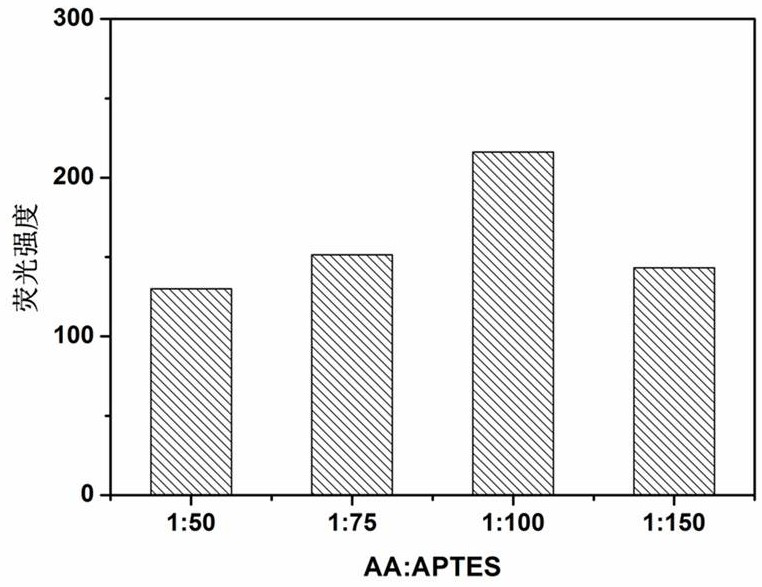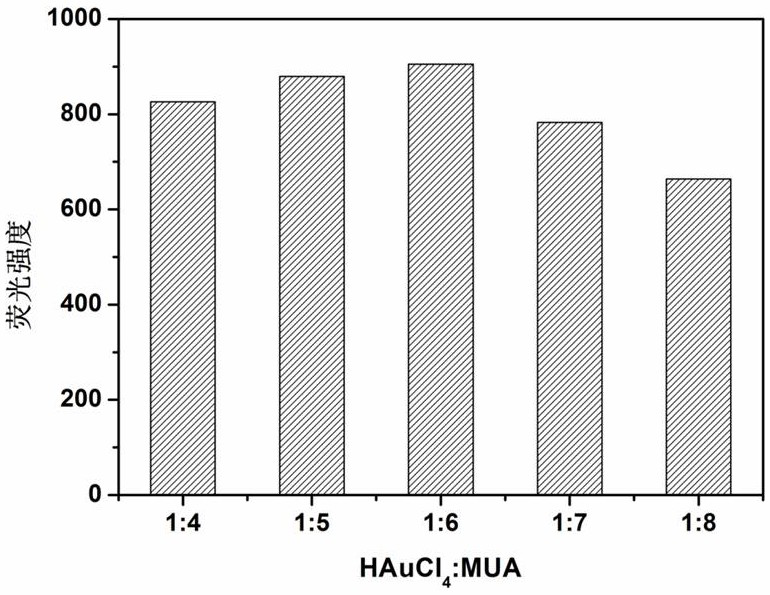Synthesis of a silicon nanoparticle/gold nanocluster ratiometric fluorescent probe and its application to the ratiometric fluorescence detection of rifampicin
A ratiometric fluorescent probe, silicon nanoparticle technology, applied in the field of fluorescent probes, can solve problems such as interference
- Summary
- Abstract
- Description
- Claims
- Application Information
AI Technical Summary
Problems solved by technology
Method used
Image
Examples
example 1
[0055] APTES in different amounts of substances was mixed with 12 mL of water to obtain an APTES solution. Add 30 μL of AA with a substance concentration of 100 mM, so that the molar ratios of AA and APTES are 1:50, 1:75, 1:100, and 1:150, respectively, and stir for 10 min; add 20 mL of Teflon In a lined reactor, the SiNPs fluorescent probe was obtained by hydrothermal reaction at 240 °C for 3 h.
[0056] figure 1 It is a bar graph of the effect of the volume ratio of AA to APTES solution on the fluorescence intensity of SiNPs. Depend on figure 1 It can be seen that when the molar ratio of AA to APTES is 1:100, the fluorescence intensity of the SiNPs fluorescent probe is the highest.
example 2
[0058] HAuCl at different volume concentrations of 10 mM 4 ·3H 2 O was mixed with 10 mL of water to obtain HAuCl 4 ·3H 2 O solution, add different amounts of MUA and 100 μL of 1 M NaOH to make HAuCl 4 ·3H 2 The molar ratios of O and MUA were 1:4, 1:5, 1:6, 1:7, and 1:8, respectively, and stirred for 5 h to obtain AuNCs fluorescent probes.
[0059] figure 2 for HAuCl 4 ·3H 2 The histogram of the effect of the volume ratio of O to MUA solution on the fluorescence intensity of AuNCs, given by figure 1 It can be seen that when HAuCl 4 ·3H 2 When the molar ratio of O to MUA solution was 1:6, the fluorescence intensity of AuNCs was the highest.
example 3
[0061] Add the solid-phase SiNPs to the HEPES buffer solution (pH ~ 7.4) to make the mass concentration 4 mg / mL, then add the solid-phase AuNCs to make the mass concentration 20 μg / mL, mix well and incubate for 0.5 h , to obtain SiNPs / AuNCs ratio fluorescent probes.
[0062] image 3 The emission fluorescence spectrum of the SiNPs / AuNCs ratio fluorescent probe. Depend on image 3 It can be seen that under the excitation spectrum with a wavelength of 300nm, the emission spectrum peaks of the SiNPs / AuNCs ratiometric fluorescent probes are at ~440 nm and ~615 nm, respectively.
PUM
| Property | Measurement | Unit |
|---|---|---|
| recovery rate | aaaaa | aaaaa |
Abstract
Description
Claims
Application Information
 Login to View More
Login to View More - R&D
- Intellectual Property
- Life Sciences
- Materials
- Tech Scout
- Unparalleled Data Quality
- Higher Quality Content
- 60% Fewer Hallucinations
Browse by: Latest US Patents, China's latest patents, Technical Efficacy Thesaurus, Application Domain, Technology Topic, Popular Technical Reports.
© 2025 PatSnap. All rights reserved.Legal|Privacy policy|Modern Slavery Act Transparency Statement|Sitemap|About US| Contact US: help@patsnap.com



